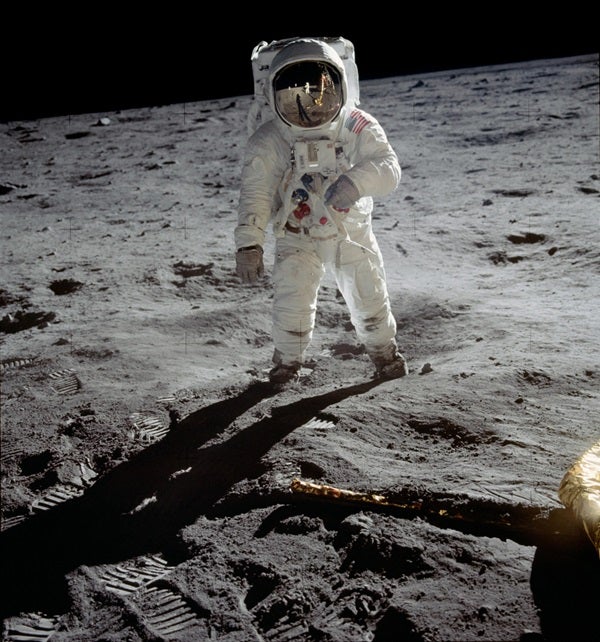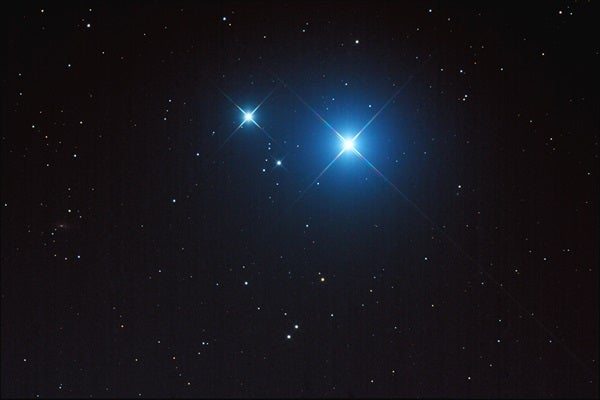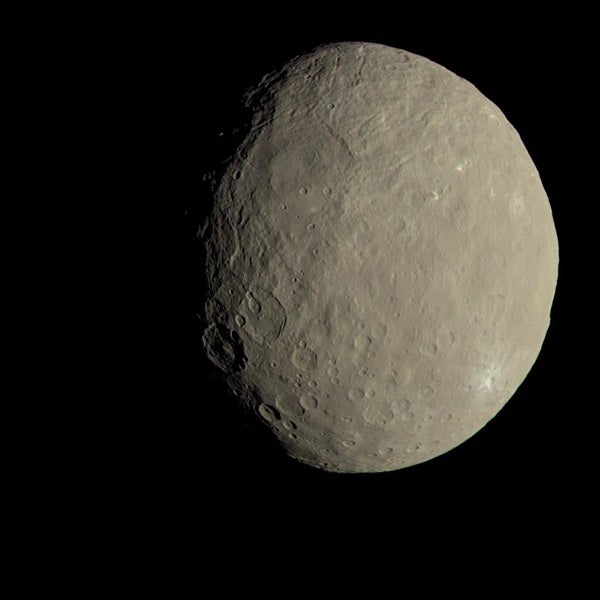The Sun’s outermost major planet, Neptune, rises around 11 p.m. local daylight time. But the best time to look for this ice giant world comes when it climbs nearly halfway to the zenith as morning twilight commences. The magnitude 7.8 planet lies in Aquarius, 1.1° east-northeast of 4th-magnitude Phi (φ) Aquarii. You can confirm your sighting of Neptune through a telescope, which reveals the planet’s 2.3″-diameter disk and blue-gray color.
Saturday, July 20
The waning gibbous Moon rises around 11 p.m. local daylight time, providing observers a chance to gaze at our only natural satellite on the golden anniversary of the Apollo 11 lunar landing. The Moon resides in Aquarius the Water-bearer tonight, nearly half the sky away from its perch in Virgo the Maiden on that historic day 50 years ago. As if to commemorate the event, the Moon reaches apogee — the farthest point in its orbit around Earth — at 7:59 p.m. EDT. It then lies 251,954 miles (405,481 kilometers) from our planet’s center.
Sunday, July 21
Magnificent Saturn reached its peak a couple of weeks ago, when it appeared opposite the Sun in the sky, and our view of the ringed planet remains spectacular. It is on display nearly all night among the background stars of Sagittarius the Archer, hanging in the southeastern sky as darkness falls and climbing high in the south by midnight local daylight time. Saturn continues to shine brightly, too, at magnitude 0.1. When viewed through a telescope, the dramatic ring system spans 42″ and tilts 25° to our line of sight, while the planet’s family of modestly bright moons appears next to the gorgeous world.
Mercury reaches inferior conjunction, passing between the Sun and Earth, at 9 a.m. EDT. The innermost planet will return to view before dawn in about two weeks.
The Big Dipper’s familiar shape appears halfway up the northwestern sky as darkness falls. One of the summer sky’s finest binocular double stars marks the bend of the dipper’s handle. Mizar shines at 2nd magnitude, some six times brighter than its 4th-magnitude companion, Alcor. Even though these two are not physically related, they make a fine sight through binoculars. (People with good eyesight often can split the pair without optical aid.) A small telescope reveals Mizar itself as double — and these components do orbit each other.
Tuesday, July 23
Although Jupiter reached opposition and peak visibility more than a month ago, it remains a stunning sight from shortly after sunset until the wee hours of the morning. It resides among the background stars of southern Ophiuchus the Serpent-bearer, a region that climbs highest in the south around 10 p.m. local daylight time. Shining at magnitude –2.5, Jupiter is the night sky’s most conspicuous object until the Moon rises shortly after midnight. When viewed through a telescope, the planet’s disk spans 44″ and shows striking cloud-top detail.
Wednesday, July 24
Last Quarter Moon occurs at 9:18 p.m. EDT. It doesn’t rise until after 12:30 a.m. local daylight time tomorrow, however, by which time its phase has diminished almost imperceptibly to 48 percent lit, at least for those of us in North America. Earth’s satellite appears against the relatively inconspicuous background stars of northern Cetus the Whale.
Thursday, July 25
Observers of the outer solar system can get a good view of Uranus before dawn. The best time to look for it is shortly before twilight begins around 4 a.m. local daylight time. Uranus then lies 40° high in the east-southeast against the backdrop of southern Aries the Ram. This morning, use binoculars to find the magnitude 5.8 planet 2.3° south of the magnitude 5.7 star 19 Arietis. A telescope reveals Uranus’ blue-green disk, which spans 3.5″.
Friday, July 26
The Southern Delta Aquariid meteor shower continues to ramp up this week. The shower has a broad maximum at the end of July, but you should see some members in the hours before dawn. And with the Moon now diminished to a waning crescent, the views improve nightly. To tell a Southern Delta Aquariid meteor from a random dust particle burning up in Earth’s atmosphere, trace the streak of light’s path backward. A shower meteor will appear to originate from the constellation Aquarius the Water-bearer.
The dwarf planet Ceres appears about 25° high in the south-southwest as darkness falls and makes a tempting target during the early evening hours. Glowing at 8th magnitude, it’s easy to find through binoculars or a telescope among the bright stars along the border between Scorpius and Libra. Tonight, Ceres lies 2.8° due west of the lovely 2nd-magnitude double star Beta (β) Scorpii. But even more impressively, it stands just 8′ northeast of the magnitude 5.0 star Lambda (λ) Librae.
Look for the waning crescent Moon this morning as it hovers just west of the Hyades star cluster in Taurus the Bull. The two objects clear the horizon by 3 a.m. local daylight time and appear some 25° high in the east as morning twilight starts to paint the sky. The Moon appears about 25 percent lit and easily outshines the stars of the V-shaped Hyades. First-magnitude Aldebaran, which marks one tip of the V, appears brighter than the rest of the cluster’s stars because it actually lies in the foreground.
Sunday, July 28
Evenings this week are a great time to explore the constellation Sagittarius the Archer. This star group lies due south and at peak altitude around 11 p.m. local daylight time, well after the last vestiges of twilight have faded away. The brightest stars within the constellation form the shape of a teapot — a distinctive asterism once you’ve found it. The central regions of the Milky Way pass through Sagittarius, so it’s always worth exploring this area through binoculars or a telescope.












